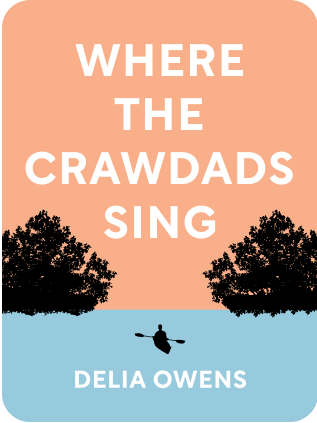

This article is an excerpt from the Shortform summary of "Where the Crawdads Sing" by Delia Owens. Shortform has the world's best summaries of books you should be reading.
Like this article? Sign up for a free trial here .
Who is “Marsh Girl?” Why do the townspeople give her this nickname in Where the Crawdads Sing?
Marsh Girl is the secretive and elusive Kya Clark, who the townspeople believe is a feral child. In Where the Crawdads Sing, Kya was abandoned at an early age by her parents, and grew up alone in her house in the Marsh near Barkley Cove.
As Kya gets older, she learns more about living with other people and how to fit in, but she remains and outsider, and remains known as “Marsh Girl.”
The Life of Marsh Girl
When she was six, Kya’s mother and siblings left one by one, leaving her with her father, an alcoholic. After struggling for a while, Kya and Pa settled into a routine, and were able to live together and survive.
On one night, Pa took Kya into town for supper at the local diner. Kya had never been to a restaurant before. Before they went inside, she tried to clean the mud off her dingy clothes and smooth her wild black mane down. Pa ignored the snide looks and comments from the other patrons and ordered them a feast for dinner, including blackberry cobbler for dessert.
Kya waited outside the diner while Pa paid the bill. A small voice said hello, and she turned to find a four-year-old girl in a snazzy dress and blonde ringlets holding her small hand out. Kya was afraid to touch the little girl because of how clean she was, but she extended her hand anyway. Before they could shake, however, Teresa White, the preacher’s wife, burst from a store and shooed Kya away. Mrs. White warned her little daughter not to go near the Marsh Girl because she was dirty. Kya didn’t have time to be offended, preoccupied as she was watching a mother show love to her child.
When Kya saw Pa coming up the lane, she ran from the house, too nervous about his reaction to the letter. She hid in the outhouse until she was sure he’d read it. After a minute, Pa slammed through the front door and stomped to his boat. Kya ran to the house to retrieve the letter, but all she found were its charred remains in the garbage. She collected the remains and stored them in a glass jar. They were the only pieces of Ma she had left.
After the letter, everything reverted back to the old ways. Pa was drunk all the time. He never took her fishing again and stopped coming home more often.
New Relations
Early one morning, Kya awoke before the sun and went mussel hunting up and down the coastline. After several hours, she’d collected two large sacks full. She motored to Jumpin’s and offered him the bags of mussels in exchange for money and gas for the boat. He gave her fifty cents and a full tank. She’d never felt so proud.
Kya had never been inside Jumpin’s store before, but on this visit, she wandered around and saw that he sold more than just fishing gear. There was food, kerosene, and toiletries, everything she needed to get by. With her fifty cents, she picked up a few supplies.
She asked Jumpin’ how many bags she could bring each week. He told her he bought mussels every three days, but other people brought them in, too. If she wanted to sell hers, she’d have to be first in line. Kya thanked him and said Pa sent his regards.
Kya started waking up earlier each day to collect mussels and oysters. Sometimes, she’d motor close to the wharf and sleep in the boat so she could be there first thing when Jumpin’ opened. She was making decent money and never had to step foot in town again for anything.
A Mysterious Benefactor
Kya turned fourteen in 1960, and although her body was becoming that of a woman, she still had the mind of a child. She hadn’t learned what came after twenty-nine and still couldn’t read. Life had continued much in the same way. She still dug for mussels and smoked fish to sell to Jumpin’, and with Mabel’s help, she’d learned how to make a garden. One of the only bad things about going to Jumpin’s was that other people saw her there. She was exposed, as was the fact that she was alone.
A year before, Kya had been lying on her porch bed when she heard voices in the night. The voices came closer to the shack, and she recognized the sounds of teenage boys, maybe five, hollering in the surrounding brush. She’d jumped from bed and tried to run out of the house before they reached her, but she was too late. The flicker of lights was already visible.
Soon, the heavy thud of hands slapping the front porch shook her heart. Each slap felt like a stab inside her body. She crouched below the solid base of the porch wall and waited. Finally, the boys ran away, cheering about surviving the wicked Marsh Girl, or Wolf Child, as some called her.
The Marsh Girl or Murderer?
When Chase Andrews was murdered, many people suspected Kya, leaning into their discrimination against her as “wild.” Sheriff Ed Jackson and Deputy Sheriff Joe Purdue were convinced it was Kya, and pursued her as a suspectt.
It was raining outside when Joe walked into Ed’s office with news. Kya was still nowhere to be found, so the deputy had gone out to Jumpin’s to see when she might be coming next. Jumpin’ had given Joe the most interesting news: Kya was gone the night Chase was killed.
Ed didn’t believe it. He knew the Marsh Girl never left the area, and he doubted she had any friends who would know about it if she did. But Joe said both Jumpin’ and Dr. Tate Walker confirmed that Kya was over in the nearby town of Greenville for two nights, including October 30. Jumpin’ said she hadn’t even heard the news when she came by the wharf a day later, and Tate was the one who’d helped her learn to take the bus to Greenville and back.
Joe believed they were back to square one, now that their main suspect had a rock-solid alibi, but Ed wasn’t quite so sure. What about Hal and Allen seeing her in the boat? He reminded Joe that sometimes a good alibi was too good. They agreed to wait until they confirmed the story before deciding what to do next.
Later that afternoon, Pansy Price knocked on the sheriff’s door. She’d heard around town, most notably from Patty Love, that the Marsh Girl was suspected of killing Chase, but she didn’t believe the rumors. She and her co-workers had seen the Marsh Girl get on a bus the afternoon of October 28 and get off the bus two days later, hours after Chase had died that morning. She’d be willing to testify to all of it.
Again, Joe assumed the investigation into the Marsh Girl was done, but Ed couldn’t be thwarted. If someone could take a bus to Greenville in the day, they could easily take one at night back to Barkley Cove. And it seemed too convenient that she allowed herself to be seen getting on and off the bus. If she was going to cover her tracks, she would have to have made her movements public. It was a brilliant plan, Ed said. The men looked at the bus departure times for Greenville. Sure enough, the times indicated that going back and forth and back again in one day was not only possible, but easy. It was time to get a warrant.
Last Chance
Tom took a different approach. He started by locating himself as one of Barkley Cove’s residents who’d heard the stories and rumors about the Marsh Girl. His speech turned emotional when he spoke about the failure of the community to support a little girl left to her own devices, choosing to ridicule and ostracize her instead. He said only Jumpin’ and his community stepped up to help Kya survive as a child. If the community had stepped in and helped this girl, her life could have been different and a town full of people wouldn’t be prejudiced against her.
Tom paused, preparing for his emotional ending. Despite her circumstances and lack of schooling, this woman, who Barkley Cove reduced to Marsh Girl, was now heralded as the Marsh Expert in scientific communities. He said it was time for this community to put aside their prejudices and see this woman for who she was. Let the persecution of this young woman finally be over.
Marsh Girl Forever
One afternoon, when Kya was sixty-four, she didn’t return from exploring in her boat. Tate went to search for her and found her lying back in the boat, seeming to be sleeping. When he got closer, fear gripped his heart. He shouted her name, but she didn’t move. Tate pulled her up by the shoulders, her long hair, now stark white, flowed behind her. He screamed his anguish to the sky and held her, rocking back and forth.
Tate buried Kya below an oak tree near the water. All the people who had once condemned her lined up to pay their respects. They had grown to marvel at the way she had survived and the life she was able to make for herself with everything that had happened. On her tombstone, Tate chose an epitaph he felt represented Kya’s life well. She had become a legend in their community, and her nickname was now distinguished. The tombstone read: “Catherine Danielle Clark, ‘Kya’, The Marsh Girl, 1945–2009.”
Kya’s nicknawas used “Marsh Girl” by the townspeople. Later, Kya embraced her love for the marsh and her expertise on the wildlife there. Upon her death, Tate was proud that she had been the Marsh Girl.

———End of Preview———
Like what you just read? Read the rest of the world's best summary of Delia Owens's "Where the Crawdads Sing" at Shortform .
Here's what you'll find in our full Where the Crawdads Sing summary :
- How Kya Clark's abandonment as a child affected her through her entire life
- How Kya discovered love despite steep obstacles
- The murder trial that embroiled Kya's town, and the ultimate truth behind the murder






